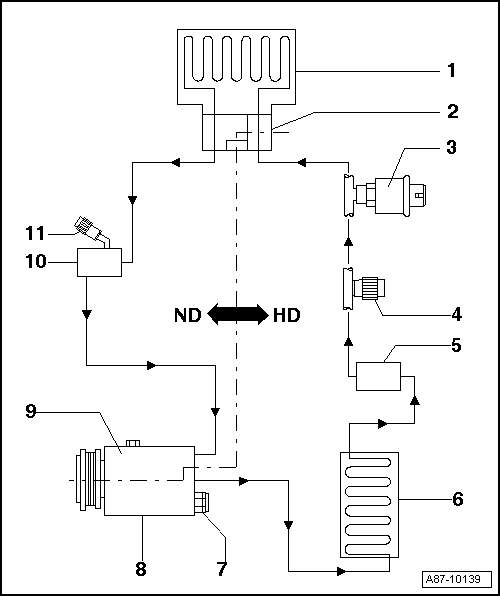A1
|
| Component | State of refrigerant | Pressure (bar) | Temperature in degrees centigrade |
| -1- Evaporator, from inlet to outlet | Vapour | approx. 1.2 bar → Remark1 | approx. -7 °C → Remark2 |
| -2- Expansion valve | Liquid, expanded to vapour | approx. 14 bar | approx. +55 °C (high-pressure end), reduced to -7 °C (low-pressure end) |
| -3- High-pressure switch / high-pressure sender | Liquid | approx. 14 bar | approx. +55 °C |
| -4- Service connection/high-pressure end and -5- Receiver | Liquid | approx. 14 bar | approx. +55 °C |
| -6- Condenser | From gas (at inlet) via vapour to liquid (at outlet) | approx. 14 bar | From approx. +65 °C (at inlet) to approx. +55 °C (at outlet) |
| -7- High-pressure safety valve and -8- Air conditioner compressor (HP side) | Gas | approx. 14 bar | approx. +65 °C |
| -9- Air conditioner compressor/low-pressure end | Gas | approx. 1.2 bar → Remark1 | approx. -1 °C → Remark2 |
| -10- Damping chamber (not fitted on all vehicles) and -11- Service connection/low-pressure end | Gas | approx. 1.2 bar → Remark1 | approx. -1 °C → Remark2 |
| 1) | 1 - The pressure in a refrigerant circuit with a regulating air conditioner compressor is maintained at approx. 2 bar absolute (corresponding to approx. 1 bar gauge) despite varying heat transfer and fluctuating engine speeds. This however only applies within the output range of the air conditioner compressor. If the output limits of the air conditioner compressor are exceeded, the pressure will increase → Chapter. |
| 2) | 2 - The temperature in a refrigerant circuit with a regulating air conditioner compressor is maintained within the regulating range of the air conditioner compressor despite varying heat transfer and fluctuating engine speeds. This however only applies within the output range of the air conditioner compressor. If the output limits of the air conditioner compressor are exceeded, the temperature will increase → Chapter. |
 Note
Note
|

| 1 - | Evaporator |
| 2 - | Expansion valve |
| 3 - | High-pressure switch / high-pressure sender |
| q | Different versions depending on vehicle |
| 4 - | Service connection/high-pressure end |
| 5 - | Receiver |
| q | Different versions depending on vehicle |
| 6 - | Condenser |
| 7 - | High-pressure safety valve |
| 8 - | Air conditioner compressor/high-pressure end |
| 9 - | Air conditioner compressor/low-pressure end |
| 10 - | Damping chamber |
| q | Not fitted on all vehicles |
| 11 - | Service connection/low-pressure end |
